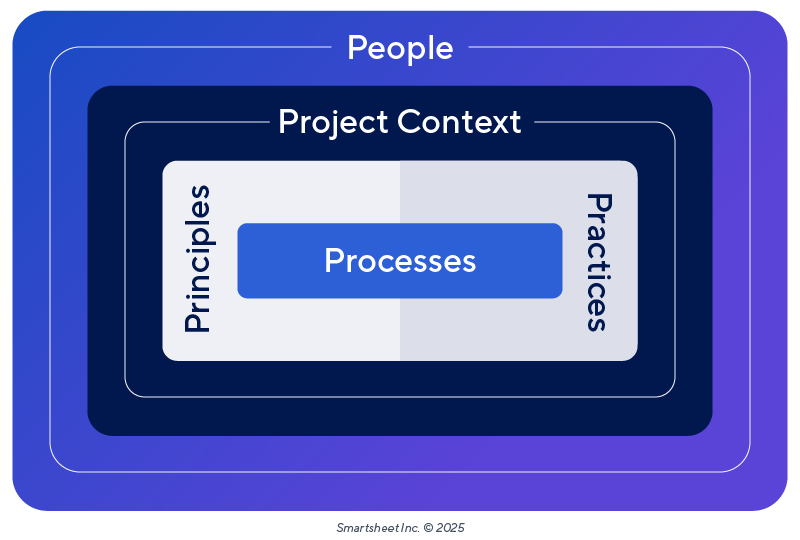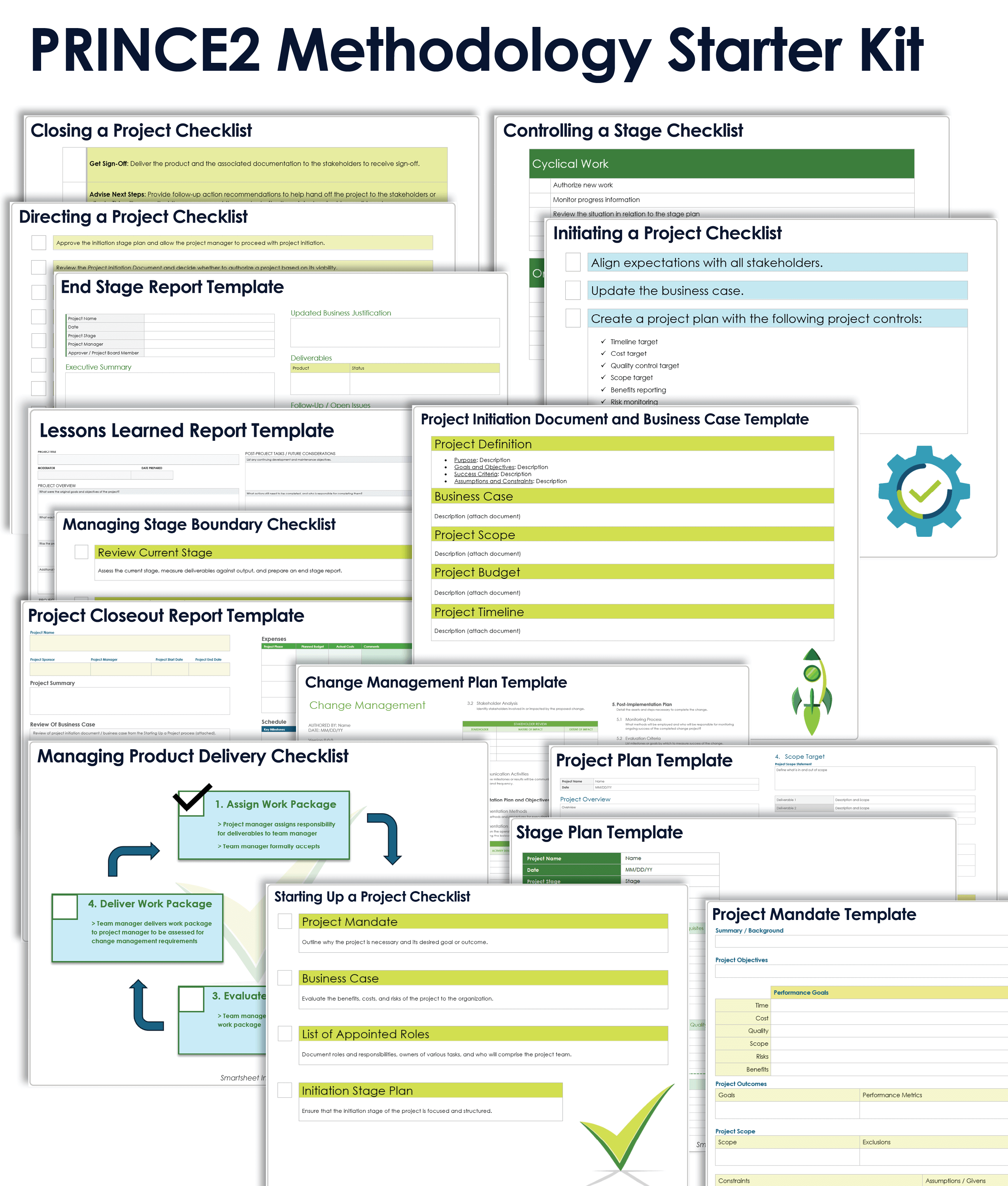What Is PRINCE2 Project Management?
PRINCE2 (Projects In Controlled Environments) is a process-based project management method that focuses on maintaining organisation and control through well-defined project stages. According to Axelos, the organisation that owns the PRINCE2 method, PRINCE2 “represents the ‘how to’ of project management.”
The UK government first developed the PRINCE2 method in the 1980s as a project management solution for IT projects. Since then, it’s been adapted to a wide range of industries. It is also flexible enough to scale to projects of different sizes. While PRINCE2 is most common in Europe, Australia, and the UK (the UK government recommends it in its list of resources for project and programme management), it is a globally recognised system and is becoming increasingly popular in the US.
For other non-PRINCE2 resources, see this collection of top project management templates for Excel.
Is PRINCE2 a Methodology or a Framework?
Frameworks refer to flexible guidelines, while methodologies are more clearly defined and prescriptive. Axelos usually refers to PRINCE2 as a methodology, though it sometimes also describes it as a framework. While PRINCE2 emphasises controlled environments, it is recognised for its flexibility.

Henny Portman, a consultant, project management trainer, and author of PRINCE2® In Practice, considers PRINCE2 a methodology: “PRINCE2 is a method that provides a structured, process-driven approach to managing projects. It offers a detailed, step-by-step process model, including defined stages, roles, and templates,” he says, adding that PRINCE2 focuses on “governance, accountability, and control” — that is, “on how a project should be managed.”
PRINCE2 has clearly defined roles and strictly delineated, manageable stages, each with specific deliverables. “This makes PRINCE2 a practical, procedural method for project execution, particularly suited for large, complex projects that require rigorous control and documentation,” Portman says.
In contrast, Portman defines PMBOK (Project Management Body of Knowledge) as a framework. “It provides a comprehensive set of principles, project performance domains, and best practices for managing projects, but does not prescribe a specific process or workflow,” he says. In other words, PMBOK, he argues, “focuses more on the ‘what’ and ‘why’ of project management rather than the ‘how.’”
PRINCE2 Practices, Processes, and Principles
The seventh edition of PRINCE2 consists of five key integrated elements: principles, practices, processes, people, and project context. Together, these elements provide a structured, adaptable framework for managing projects. Principles ensure projects follow PRINCE2 guidelines, practices cover essential aspects of project management, and processes outline the project lifecycle.
People is the most recent edition to the PRINCE2 elements. “Projects rely on people — both those working on the project and those affected by it,” Portman says. “Understanding their needs, capabilities, motivations, and the relationships between them is essential for effectively establishing and managing the project.”
Project context refers to the specific circumstances in which a project operates, governing how teams tailor and implement principles, practices, and processes to ensure that the PRINCE2 method aligns with the project’s needs.

The Five Key Elements of PRINCE2
| PRINCE2 Principles | PRINCE2 Processes | PRINCE2 Practices |
|---|---|---|
These fundamentals ensure that a project operates according to PRINCE2 guidelines. There are seven principles, and a project can only qualify as a PRINCE2 project if it applies them all. Here are the seven PRINCE2 principles:
| These outline the entire project lifecycle, from pre-start activities to project delivery and closure. The principles and practices support the end goal of carrying out necessary processes. Each process includes checklists of recommended activities and clearly assigned responsibilities. Here are the seven PRINCE2 processes:
| These are the essential aspects of project management that must be applied throughout the project. Each practice explains how to effectively manage an aspect of project management within the PRINCE2 processes and why it is crucial to their success. Here are the seven PRINCE2 practices:
|
PRINCE2 Principles Case Study
Henny Portman, who owns and directs his own project management consultancy, recalls taking over operations when project delivery was weak and many projects faced delays, partly due to project sponsors failing to make critical decisions or provide direction. “It quickly became clear that each project manager was using their own project management method. In other words, everyone was reinventing the wheel,” he says. “Additionally, I questioned the purpose of several projects. Why were we even doing them? What value did they bring?”
Portman realised that it was imperative to introduce PRINCE2 to help not just project managers, but everyone involved. “My goal was to create a common approach and shared language, ensuring that both project managers and sponsors understood their roles, responsibilities, and decision-making processes,” he says. Having all project managers using the same method allowed for consistency and structure across the organisation.
“Using the PRINCE2 principle of continued business justification, we evaluated all ongoing projects. It became clear that several in-flight projects no longer aligned with business objectives and had to be stopped,” he says. “This decision freed up scarce resources, which we could redirect to higher-priority projects or use to reduce staff overallocation, alleviating pressure on our teams. The result was more focus and a crucial first step in reducing our overloaded project portfolio.”
Portman’s team also established project boards with clear roles and responsibilities, ensuring that projects had strong governance. “By applying the PRINCE2 principle of managing by exception and setting clear tolerances for project performance, we empowered project managers to handle issues within their limits,” he says. The project board only stepped in when these tolerances were exceeded, allowing them to maintain focus and keep their workload as light as possible. It also “ensured that decisions were made at the lowest possible level, without constant delays waiting for sponsor approval,” Portman says.
In addition, the team applied the PRINCE2 principle of learning from experience. This involved building a repository of insights and lessons learned, then sharing them with teams at the end of each project. “Over time, this collective learning became a valuable asset, improving our processes and decision-making,” Portman says.
The result of implementing these changes was significant. “Far more projects were delivered on time and within budget, and our teams became more efficient, focused, and empowered,” says Portman. “This transformation not only improved project delivery but also boosted confidence across the organisation, proving that a structured, principle-driven approach such as PRINCE2 can truly make a difference.”
The 7 Processes of PRINCE2
The seven PRINCE2 processes are: starting up a project, directing a project, initiating a project, controlling a stage, managing product delivery, managing stage boundaries, and closing a project. Together, these processes guide a project from initiation to completion, ensuring clear governance.
The Seven Processes of PRINCE2
The seven processes of the PRINCE2 method don’t make up a linear timeline. Some processes are ongoing throughout the entire duration of the project, while others are recurring steps.
Here is a detailed look at each of the seven processes of PRINCE2:
- Starting Up a Project: This is a pre-project process aimed at ensuring a project is viable and worthwhile for the organisation, and all the required conditions for initiating the project exist.
Starting up a project requires these key elements:
- Project Mandate: This outlines why the project is necessary and its desired goal or outcome.
- Business Case: This evaluates the benefits, costs, and risks of the project to the organisation. Regularly review your business case throughout the process to ensure business justification.
- Roles and Responsibilities Documentation: This establishes appointed roles and defines who will comprise the project team.
- Initiation Stage Plan: This ensures that the initiation stage of the project is focused and structured.
These are the key activities that take place during the starting-up process:
- Appointing the executive and project manager
- Capturing lessons from previous projects
- Designing and appointing the project management team
- Preparing a business case outline
- Selecting the project approach
- Assembling the project brief
- Planning the initiation stage
Hazel Bird, Founder of the editorial and publishing project management consultancy Wordstitch Editorial, explains the processes of PRINCE2 as she applies them to the publishing industry. During the starting up of a project process, she says, “somebody identifies that there may be an opportunity to publish text that readers want, whether that’s a novel, a technical manual, an encyclopaedia, or something else.”
After that, she says, the team has to “verify that the project will be worthwhile.” In publishing, business justification might mean ensuring a project has “sufficient benefits in terms of readership, revenue, prestige, and anything else important to the publisher,” says Bird.
- Directing a Project: This is an ongoing process that runs from the start of a project until closure. It is the responsibility of the project board, which oversees project progress to ensure alignment with the organisation’s objectives. The project board sets policies and guidelines for governance, decides on a budget, and approves the project plan.
For example, during the controlling-a-stage process, a project manager might be interacting with various product delivery teams. These teams will produce highlight reports to indicate that they have finished certain sprints.
“They may come up with some exceptions,” adds Robert Pinnington, Founder of PCDA Consulting and a solutions owner for IKEA. “Perhaps their project tolerances have been exceeding, whether by time or by cost. At that point, the project manager will talk to the project executive, saying, ‘Look, we’re about to exceed a tolerance here. What do you want us to do? Do you want us to close down the project? Do you want us to assign some more time? Do you want us to assign some more budget?’”
He also explains that the project executive continuously provides this information through directing a project process.
Directing a project is essential for maintaining control while allowing the project manager to handle day-to-day operations. It ensures that the project remains viable, aligns with organisational goals, and has the necessary resources to succeed.
The project board has several key responsibilities while directing a project:
- Authorise Initiation: Approve the initiation stage plan and allow the project manager to proceed with project initiation.
- Evaluate Viability: Review the project initiation document and decide whether to authorise a project based on its viability.
- Oversee Stage Plans: Review and approve each stage plan and provide guidance to the project manager.
- Define Limits: Set tolerances for each stage of the project and define exceptions.
- Track Progress: Monitor progress through regular reports. When necessary, respond to these reports and changes in the project environment.
- Ensure Justification: Ensure continued business justification.
- Make Key Decisions: Make any necessary decisions at critical points in the project lifecycle.
- Close the Project: Authorise project closure.
“As a project manager, I report to my client (who represents the project board) on any exceptions,” Bird says. In a publishing project, these exceptions could include “the editing taking longer than expected, the author not responding to queries on time, images not being of suitable quality, content being missing, and other suppliers (e.g. copy editors) delivering substandard work.” In any of these situations, the project board helps to course correct.
The level of project board involvement depends on the type of project. “For example, imagine a self-publishing author (the client/board) working with an editorial consultant (the project manager, who also does the work). They will generally have a close and collaborative working relationship, and both will know the project inside out,” Bird says. In this situation, the board and the project manager will work together to get the project back on track.
“In contrast, imagine a non-profit’s marketing department (the client/board) commissioning the editing of a report,” she says. “In this situation, the client may provide a vague specification and expect the editor to solve all non-critical exceptions independently.”
- Initiating a Project: This process involves detailed planning of the project’s deliverables. Its key output is the project initiation document, which defines project objectives, scope, and deliverables; establishes a timeline; and outlines quality standards and control mechanisms.
The main goals of this process are to establish the project board’s ownership and ensure ongoing business justification.
Initiating a project requires the following key activities to be completed:
- Align Expectations: Ensure all stakeholders are clear on the project’s objectives, necessity, execution plan, and respective responsibilities.
- Refine Business Case: Conduct a detailed cost-benefit analysis and assess risks and opportunities in carrying out the project.
- Create a Project Plan: Define project stages, establish a timeline with specific deliverables, allocate resources (labor, time, and budget), and develop a communication management plan.
- Establish Project Controls: Set targets for time, cost, quality, scope, benefits, and risk. Implement processes for reporting, risk monitoring, quality control, and change control.
With publishing, Bird says, the process of initiating a project involves assembling a team. “The members will depend on the scale of the project and the type of publisher, but they might include authors, editors, typesetters, designers, proofreaders, indexers, rights managers, marketers, publicists, and many others,” she says.
Then, she might receive specifications from the stakeholder. “I receive a brief from the client specifying things such as the desired completion date, who I’ll be dealing with, technical requirements (e.g., spelling style, referencing style, author preferences), and any special requirements,” she says. “From this I start to develop a style sheet, which is a key document that specifies the approach to spelling, punctuation, and many other things. Documentation is also produced to manage things like assets and clearing copyright.”
Controlling a Stage: This process is one of the project manager’s primary responsibilities and involves managing activities in each project stage to keep the project on track.
During this process, the team creates work packages, progress reports, and risk mitigation plans. At this point, the project manager and other stakeholders monitor progress and take corrective measures or repeat processes from earlier stages as needed.
For more help with risk management, see these free risk register templates.
Controlling a stage involves these key activities:
Cyclical Work Ongoing Tasks - Authorise new work.
- Monitor progress information.
- Review the situation in relation to the stage plan.
- Sign off on completed work.
- Repeat the process and issue new work.
- Report on progress to the project board.
- Assess risks.
- Take corrective action if necessary.
As a project manager, Bird spends the bulk of her time on this process. Using the client brief and industry knowledge, she creates briefs for each team member: copy editors, proofreaders, typesetters, indexers, and more. “I keep my own project log and report exceptions to the client,” she says. “I ensure the style sheet is updated to reflect the project as it evolves, and I manage the updating of asset logs, lists of copyright credits, and anything else the project needs.”
Managing Product Delivery: This process goes hand in hand with controlling a stage. These two processes occur simultaneously but are handled by different roles. Controlling a stage covers the project manager’s activities, while managing product delivery is the team manager’s responsibility. Both processes should align to achieve the same outcome at each stage.
Controlling a Stage and Managing Product Delivery Cycle
This process formalises the relationship between the team manager and the project manager, ensuring that teams properly conduct and document authorisation, monitoring, execution, and delivery of project work. The team manager coordinates work across stages to deliver individual products required by the project, achieving the goals of a work package.
These are the key ongoing activities associated with this process:
- Accepting the Work Package: The team manager formally takes responsibility for a specific set of project deliverables, as defined within a work package, committing to delivering them according to agreed-upon quality standards and time frames.
- Executing the Work Package: The team manager ensures that work is executed and monitored to be in line with the authorised work package requirements. If the team can’t meet these requirements, the team manager must escalate the issue to the project manager.
- Evaluating the Work Package: The team manager must regularly assess and review the status of the package.
- Completing and Delivering the Work Package: After review, the team manager returns the completed work package to the project manager for quality approval. Any subsequent changes must follow the change control process.
The team manager might be an external contractor or supplier for the project. If their work does not meet expectations, they might need to be replaced. To determine whether this is necessary, says Bird, “I assess completed work against the briefs that I created for each person.”
In editorial or publishing projects, substandard work might mean that portions of the text require re-editing, or some aspect of the brief is missing. “If corrective work is needed, I always aim to give the supplier the chance to fix it themselves before any more drastic action is taken (e.g., sending it to a different supplier),” she says.
- Managing Stage Boundaries: A key responsibility of the project manager is identifying the different stages of a project and producing a stage plan — or a more detailed version of the project plan — for each. Once a stage is complete, the project board and executives begin the managing stage boundaries process.
At several points during the project lifecycle, the board assesses the project’s status by reviewing the project manager’s evaluations and revised plans. “You say to the project executive, ‘This stage is now completed. We’ve assessed it according to the business justification (because you have to do continued business justification), and we’re going to see if this project is still worthwhile,’” says Robert Pinnington. “Then you need authority to move on to the next stage, and then you do the same thing again.”
During the process of managing a stage boundary, the project manager must accomplish the following activities:
- Review the Current Stage: Assess the completed stage and measure deliverables against expected outcomes. Prepare an end stage report.
- Prepare a Stage Plan: Prepare or review the stage plan for the following stage, including risk assessment and resource allocation.
- Update the Project Plan: Incorporate metrics from the completed stage and revise timelines and resource allocations for the next stage.
- Update the Business Case: Reassess the project costs, benefits, risks, and opportunities, and confirm continued business justification. Without this confirmation, the project cannot proceed.
In editorial work, the critical stage boundary occurs once the author and developmental editor have written or developed the text. After this process, Bird says, “it’s vital not to proceed to more detailed levels of editing (copyediting and proofreading) and design work unless the text meets the required specifications in terms of size, quality, and coverage.” At this point, the project manager would have to carefully assess the text and confirm that it aligns with the project requirements before moving on to copyediting.
This is not always easy. “Clients aren’t always willing to make hard decisions at this stage, and it’s not uncommon for projects to be moved forward to copyediting when what they really needed was an extra stage of writing/development,” Bird says. “You never want to be moving on to a more detailed stage of editing unless the goals for the previous stage have been met. For example, there is no point correcting typos in a book whose chapters are in a totally unsuitable order.”
- Closing a Project: During this process, the team formally closes the project and presents a report to the project board.These are the two main objectives of project closure:
1. Hand Off Deliverables: Ensure the client accepts the project deliverables as is and ensure they can be supported once the project is closed and formally disbanded.
2. Review Project: Review the original objectives to see what was accomplished and identify unmet goals. Go over the project’s benefits and any remaining issues or risks. Document key lessons for use in future projects.
The following actions should be completed during the project closure process:
- Get Sign-Off: Deliver the product and all associated documentation to the stakeholders for approval.
- Advise Next Steps: Provide follow-up recommendations to help stakeholders or clients with handover. This will ensure they can support the product after project closure.
- Release Resources: Wrap up contracts, pay final invoices, and release or reassign all remaining resources, whether equipment or personnel.
- Update All Documents: Finalise the following documents:
- Configuration Item Record: Created at the start of the project if the project’s change control approach requires it, this document notes the history, status, approvals, and version of each configuration item, as well as the relationships between different versions.
- Benefits Management Approach: This document outlines the product’s benefits and how to measure them once the project handover is complete.
- Lessons Report: This report should capture key lessons from the project, both positive and negative, to inform future projects. In it, the project manager reviews objectives, strategies, final deliverables, and team performance.
- End Project Report: Compiled during project closure, this report lists ongoing risks or issues, quality assessments, and recommended follow-up actions. While parts of this report might be completed post-handover, the project board still reviews it before formally closing the project.
In publishing, a project is closed when the digital product is sent for publication or printing. Bird emphasises the importance of double-checking that every item in the client’s brief has been addressed before finalising handover. “I provide them with a report of the project’s status and anything they need to know after the files leave my hands to ensure the project completes smoothly,” she says.
The 7 Processes of PRINCE2 Starter Kit

Download the 7 Processes of PRINCE2 Starter Kit
Use this free starter kit to help you thoroughly conduct each process of the PRINCE2 method. It includes checklists of everything required for each process.
In this kit, you’ll find:
Starting Up a Project
- A starting-up-a-project checklist for Microsoft Word and Adobe PDF to ensure all prerequisites for a project are in place
- A project mandate template for Microsoft Word and Adobe PDF to document the project’s necessity, goals, and benefits to the organization
- A
project initiation document and business case template for Microsoft Word
and
Adobe PDF
to outline the project’s benefits, costs, and risks, ensuring continued business justification
Directing a Project
- A
directing-a-project checklist for Microsoft Word
and
Adobe PDF
to help you monitor and control the project from start to finish
Initiating a Project
- An initiating-a-project checklist for Microsoft Word and Adobe PDF to help you get the project off the ground
- A project plan template for Excel , Microsoft Word ,and Adobe PDF to keep the project organized and help you monitor high-level progress
- A
change management plan template for Microsoft Word
to manage deviations from the project plan
Controlling a Stage
- A
controlling-a-stage checklist for Microsoft Word
and
Adobe PDF
to ensure project stages remain on track and aligned with objectives
Managing Product Delivery
- A
managing-product-delivery checklist for Microsoft Word
and
Adobe PDF
to oversee and ensure the successful delivery of project outputs
Managing Stage Boundary
- A managing-stage-boundary checklist for Microsoft Word and Adobe PDF to assess progress and determine next steps before moving to a new stage
- A stage plan template for Excel for planning the objectives of each project stage to plan and define the objectives of each project stage
- An
end stage report template for Microsoft Word
and
Adobe PDF
to help you compare the outcome of the project stage against the stage plan
Closing a Project
- A closing-a-project checklist for Microsoft Word and Adobe PDF to ensure all final tasks are completed before closing the project
- A lessons learned report template for Microsoft Word and Adobe PDF to document key learnings for future projects
- A project closeout report template for Microsoft Word and Adobe PDF to summarize the project’s overall success, challenges, and outcomes
Benefits of PRINCE2
PRINCE2 offers benefits to both the project and project manager. The method ensures that a project stays on track and that the product or deliverable is always top of mind. The globally recognised PRINCE2 certification is also a helpful tool for managers wanting career and salary advancements.
“If I had to pick one aspect of the PRINCE2 method that stands out for me, it’s the ‘focus on products’ principle. Perfection for the sake of perfection doesn’t necessarily serve the reader,” Bird says. “More broadly, I appreciate the common-sense and unobtrusive nature of PRINCE2. For the projects I work on, I rarely need to consciously think about implementing PRINCE2. However, when I have a problem, I often find that the principles and processes help to suggest a way forward — or at least put the matter into perspective.”
Check out this guide to PRINCE2 certifications for tips on preparing to get qualified.
PRINCE2 benefits a project by focusing on the following key areas:
- Quality and Best Practices: Every phase is designed to meet stakeholder and project team needs, while ensuring the product develops as required by the project brief.
- Measurable Stages: Breaking down a project into manageable stages makes it easier to monitor progress and keep things on track — or to quickly correct course if necessary.
- Effective Communication: With PRINCE2, the insistence on processes and documentation helps reduce miscommunication.
- Risk Management: PRINCE2 includes built-in processes to help manage risks, preventing unexpected issues from disrupting the next stage.
PRINCE2 benefits project managers by adding value to the following areas:
- Skills: Studying PRINCE2 strengthens core project management skills that are applicable when both contributing to and managing projects.
- Career: PRINCE2 certifications boost job prospects, particularly in a growing and increasingly global job market.
- Salary: Certifications can help a manager land a higher salary or qualify for a better position.
- Confidence: Extra qualifications and knowledge help boost a manager’s confidence so they can take on greater responsibilities and apply their skills effectively.
PRINCE2 Project Management Roles
Project management roles in PRINCE2 include the project board, which oversees the project’s direction and approves major decisions; the project manager, responsible for day-to-day management and reporting; and the team manager, who ensures work is completed to standard. PRINCE2 defines these and other roles to ensure proper accountability and communication.
Though some of these may overlap, the following are all important roles in the PRINCE2 method:
- Project Board: This consists of the executive, senior user, and senior supplier who decide when a stage is complete and authorise progression to the next. They also approve major plans, set stage tolerances, communicate with stakeholders, allocate funds, and ensure required resources are available for each stage.
- Change Authority: Anyone with this designation has authority to approve changes when deliverables don’t meet requirements or when changes are requested.
- Project Manager: The project manager is responsible for managing day-to-day activities, including reviewing timelines and budget. They monitor project controls to keep a project on track. These include time, cost, quality, scope, benefits, and risks. They also provide the project board with progress reports.
- Project Assurance: This responsibility involves assuring clients or stakeholders that the project is being conducted correctly. This role is often external to the project teams.
- Team Manager: The team manager ensures that the team follows the project manager’s instructions and creates the product according to their specifications, while also adhering to the project controls. They provide the project manager with reports and updates, just as the project manager does for the board.
Take Control of PRINCE2 Project Management With Smartsheet
From simple task management and project planning to complex resource and portfolio management, Smartsheet helps you improve collaboration and increase work velocity -- empowering you to get more done.
The Smartsheet platform makes it easy to plan, capture, manage, and report on work from anywhere, helping your team be more effective and get more done. Report on key metrics and get real-time visibility into work as it happens with roll-up reports, dashboards, and automated workflows built to keep your team connected and informed.
When teams have clarity into the work getting done, there’s no telling how much more they can accomplish in the same amount of time. Try Smartsheet for free, today.

